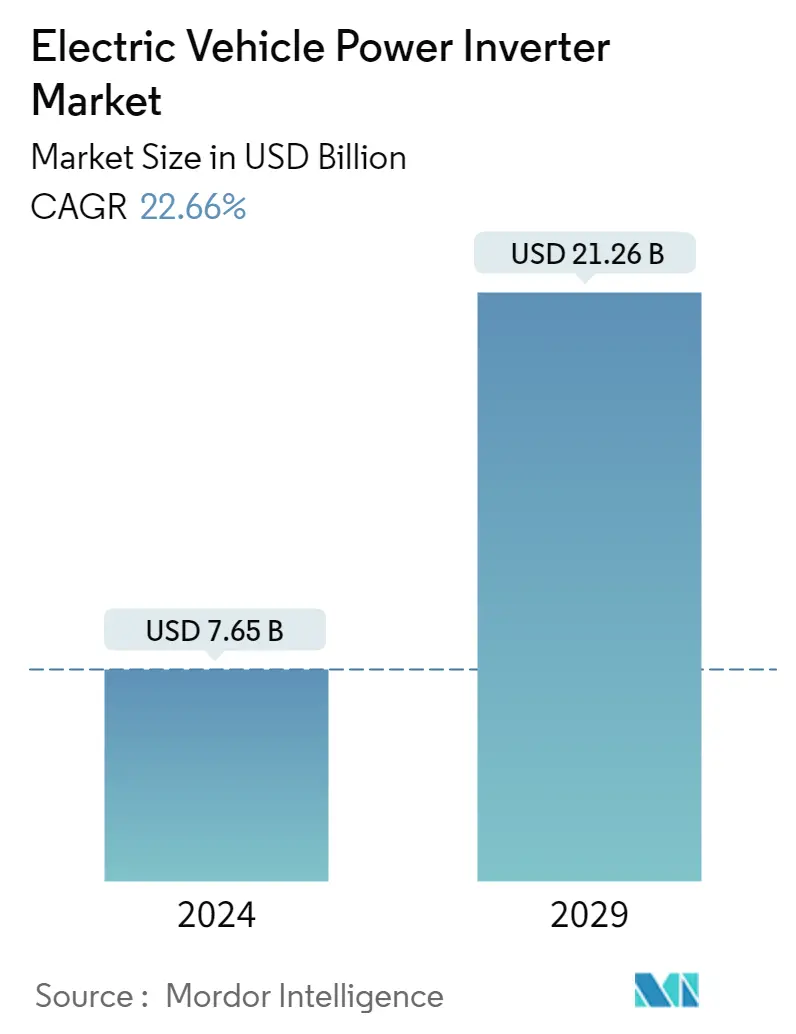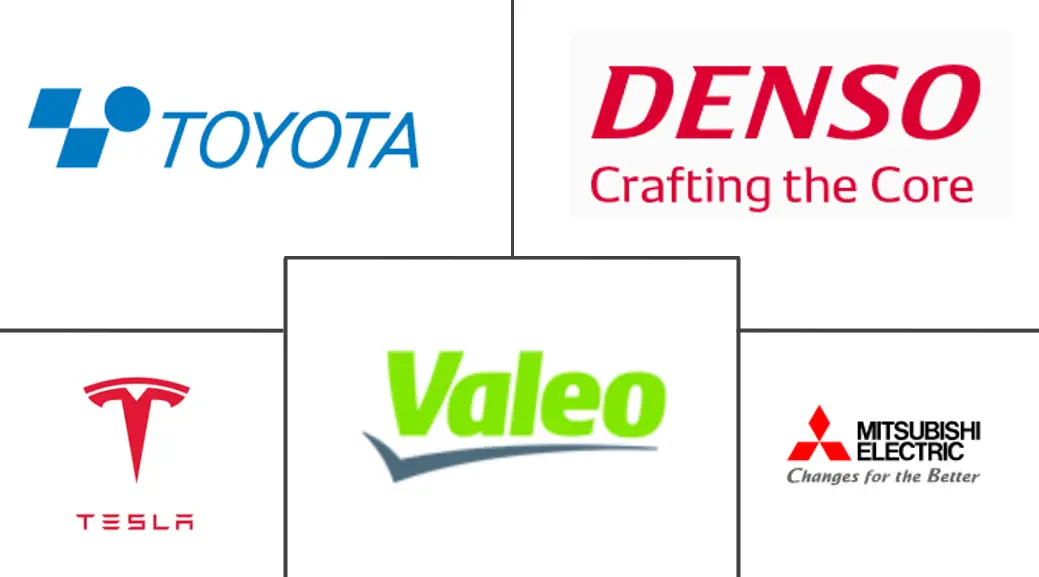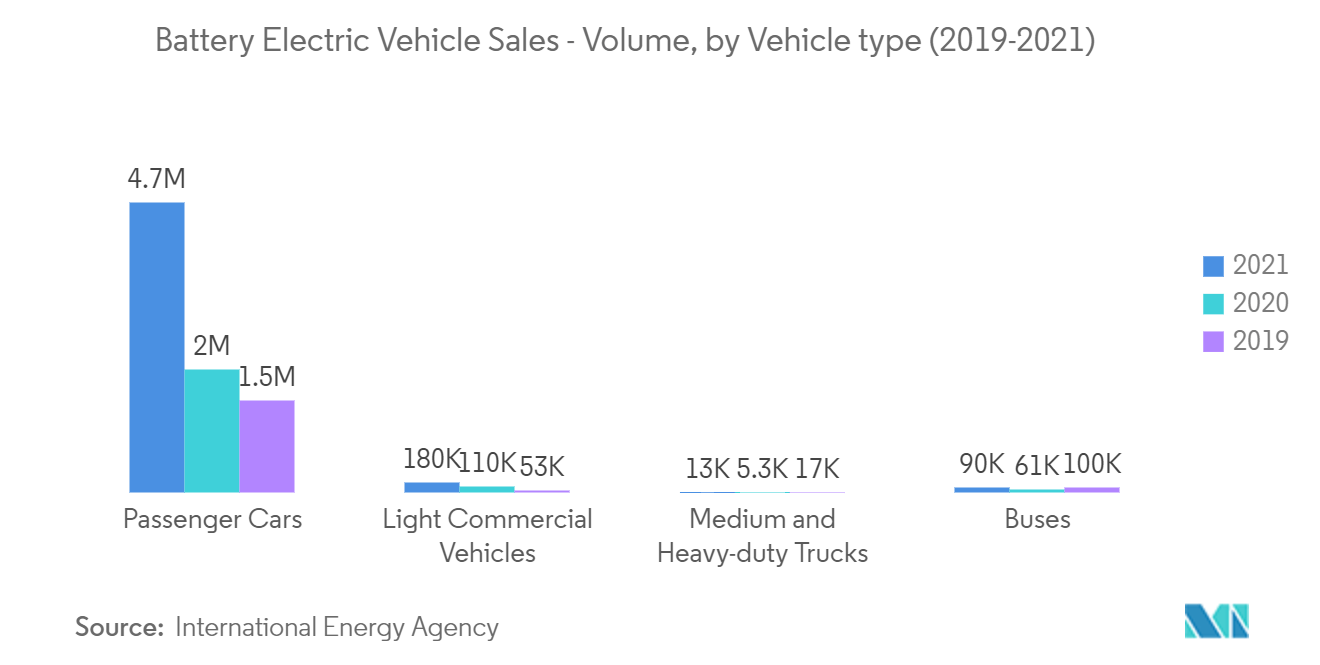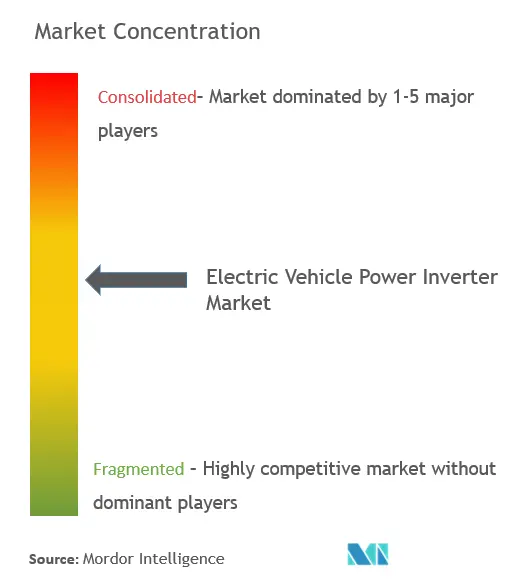EV Power Inverter Market Size

| Study Period | 2020 - 2029 |
| Market Size (2024) | USD 7.65 Billion |
| Market Size (2029) | USD 21.26 Billion |
| CAGR (2024 - 2029) | 22.66 % |
| Fastest Growing Market | Europe |
| Largest Market | Asia-Pacific |
Major Players
*Disclaimer: Major Players sorted in no particular order |
EV Power Inverter Market Analysis
The Electric Vehicle Power Inverter Market size is estimated at USD 7.65 billion in 2024, and is expected to reach USD 21.26 billion by 2029, growing at a CAGR of 22.66% during the forecast period (2024-2029).
The pandemic has affected almost every industry around the globe; however, the demand for the electric vehicle power inverter market is growing significantly, owing to factors, such as the continuous demand and sales of electric vehicles every year. For instance, despite the pandemic, the sales of electric vehicles, such as passenger cars, have shown positive growth in various countries in the regions, such as Asia-Pacific and Europe. However, The automotive industry witnessed significant growth in terms of electric vehicle production in 2021, which is likely to increase the demand for power inverters during the forecast period.
Over the medium term, governments in various countries are spending heavily on electric mobility projects, which are going to provide an opportunity for electric vehicle power inverter manufacturers, as governments are encouraging automobile manufacturers and customers to produce and adopt electric vehicles. The rise in the demand for electric vehicles is also expected to increase the sales of the components used in electric vehicles, such as power inverters.
With growing stringent emission standards across the globe, automakers are gradually shifting their production from conventional engine vehicles to hybrid and electric vehicles. In addition, governments have initiated incentives, such as a cut down in vehicle tax, bonus payments, and premiums, for buyers of electric vehicles in the respective countries to support electric vehicle sales growth. Also, the increasing charging station facilities in the regions, especially in Europe, North America, and Asia-Pacific, particularly in Japan and China, have further supported the growing electric vehicle sales.
Several manufacturers have raised the bar to go beyond the announcements related to electric vehicles with an outlook beyond 2025. More than ten of the largest OEMs have declared electrification targets for 2030 and beyond. Significantly, some OEMs plan to reconfigure their product lines to produce only electric vehicles. For instance, in the first trimester of 2021, General Motors announced its plans to raise its spending on electric and autonomous vehicles to USD 20 billion by 2025. The company is expected to launch 20 new electric models by 2023 and aims to sell more than 1 million electric cars a year in the United States and China over the forecast period.
EV Power Inverter Market Trends
This section covers the major market trends shaping the Electric Vehicle Power Inverter Market according to our research experts:
Growing Sales of Electric Vehicles
Electric vehicles have become an integral part of the automotive industry, and they represent a pathway toward achieving energy efficiency, along with reduced emissions of pollutants and other greenhouse gases. The increasing environmental concerns, coupled with favorable government initiatives, are some of the major factors driving the market growth.
Global battery electric vehicle sales were marked at 3.5 million units in 2021, which was significantly higher compared to sales figures in 2020. The movement to accelerate the adoption of light-duty passenger electric cars (EVs) and phase out traditional vehicles with internal combustion engines is gaining traction around the world. The increase in average fuel prices reflects the fact that Europe has a higher share of new electric car registrations than other parts of the world. Hence, mass adoption of electric vehicles, owing to rising fuel prices, is expected to proliferate business globally.
Rising government investment in the development of charging infrastructure across the globe is likely to promote the sale of electric vehicles. For instance,
- In October 2022, the German government invested Euro 6.3 Billion (USD 6.1 Billion) to increase the number of charging stations across the country.
- In September 2022, Japanese leasing company Orix announced the installation of electric vehicle charging stations across the country. The company will build around 50,000 charging stations by 2025 in partnership with Ubiden.
Moreover, the high cost associated with batteries has necessitated the improvement of inverters and other power electronics, along with improving the performance of vehicles. For instance,
Shifting customer preference towards electric vehicles is an evident sign for future decarbonization and simultaneously decisive for charging stations, although penetration of EVs is subjected to various attributes, including consumer behavior, infrastructure, and certain regional clusters. An increase in electric vehicle sales will proportionally fuel the demand for charging stations. Prominent players in the market have diagnosed the pinpoint of consumer sentiment and thus are focusing on catering to it by offering fast-charging technologies across the country.
Though change has not resulted in a slump in IC engine vehicle sales, it created a promising market for electric vehicles in the present and future. The above trend has propelled some of the automakers to increase their expenditure on R&D in electric vehicles and associated components, like power inverters, while others have started focusing on launching new products to capture the market share, eventually pushing the demand in the market.

Asia-Pacific is leading the Electric Vehicle Power Inverter Market
Asia-Pacific is leading the electric vehicle power inverter market, followed by Europe and North America, respectively. The sale of electric vehicles in China is growing at a rapid pace. Despite a global downturn in auto sales due to a shortage of semiconductor supply caused by COVID-19 pandemic, electric vehicle sales in China increased by 154 percent last year, as more people chose cleaner vehicles. Electric vehicle (EV) manufacturers sold a total of 3.3 million units in China in 2021, up from 1.3 million in 2020 and 1.2 million in 2019.
The government of India has undertaken multiple initiatives to promote the manufacturing and adoption of electric vehicles in India to reduce emissions pertaining to international conventions and develop e-mobility in the wake of rapid urbanization. With the increasing sales of electric vehicles in India, automakers are investing in the development of new technologies and increasing their production capacities to accommodate the demand. For instance,
- In May 2022, Toyota Group revealed plans to invest INR 48 billion (USD 624 million) in India to manufacture electric vehicle components.
- In March 2022, Suzuki Motor, the parent company of Maruti Suzuki, announced that it will spend INR 10,440 crore in India to develop a new electric car and battery facility.
Key automakers in India are also working on research and development activities to develop new products which would positively impact the target market growth during the forecast period. For instance,
- In March 2022, Toyota Kirloskar Motor unveiled a project to introduce India's first hydrogen-powered fuel cell electric car as one of the biggest emerging car markets looks to expedite its transition to clean transport. Toyota will work with the government's testing agency International Centre for Automotive Technology, to study the fuel cell electric car Mirai for Indian roads and climatic conditions. The Toyota Mirai car shall be manufactured at Toyota's Kirloskar Plant in Karnataka.
By 2030, Japan wants next-generation vehicles to account for 50-70 percent of new vehicle sales, with battery electric vehicles (BEVs) and plug-in hybrid electric vehicles (PHEVs) accounting for 20-30 percent and hybrid electric vehicles (HEVs) accounting for 30-40 percent. To achieve that, in November 2021, The Japanese government earmarked a total of JPY 37.5 billion (EUR 290 million) for e-mobility. However, the primary hindrance the market is facing is the aged and poor charging infrastructure. Hence, Japan is aiming to increase the number of EV charging stations nationwide to 150,000 by 2030.
Several major players announced partnerships to co-develop EV solutions in the country. For instance,
- In March 2022, Sony Group Corporation and Honda Motor Co., Ltd have agreed to forging a strategic collaboration and have signed a memorandum of understanding (MOU) outlining their intention to form a joint venture to collaborate on the development and distribution of high-value-added battery electric vehicles (EVs).
Various automakers are also providing home charging solutions to their customers along with electric vehicles, for instance.
- In October 2022, ENECHANGE Ltd announced the installation of 30,000 EV chargers in Japan by 2027. All EV chargers 47 prefectures in Japan have decided to introduce our EV charging service.
The demand for power inverters is expected to grow simultaneously with the growing trend of hybrid and electric vehicle sales around the world during the forecast period.

EV Power Inverter Industry Overview
The global electric vehicle power inverter market is dominated by a few players such as Continental AG, Robert Bosch GmbH, DENSO Corporation, and Mitsubishi Electric Corporation. The companies are expanding their business by opening new production plants and making joint ventures so that they can have an edge over their competitors. For instance,
- In November 2022, Continental AG completed the construction of the third expansion of the electronic components factory in Timișoara. The company invested Euro 40 Million for the manufacturing operation facility which will enhance the production capacity of electric vehicle components across the country.
- In October 2021, Robert Bosch debuted a new CV-specific electric motor and inverter. This 230 e-motor can be paired with Bosch's advanced Sic inverter to cut down on energy losses and increase the driving range of commercial vehicles.
- In May 2021, Robert Bosch, in association with Porsche and Fraunhofer Institute for Reliability and Micro integration (Fraunhofer IZM) in Berlin, announced a new project aimed at increasing the range of electric vehicles (EVs) by enhancing the performance of power inverters in vehicles.
EV Power Inverter Market Leaders
-
DENSOCorporation
-
Mitsubishi Electric Corporation
-
Tesla, Inc.
-
Toyota Industries Corporation
-
Valeo SA
*Disclaimer: Major Players sorted in no particular order

EV Power Inverter Market News
- In September 2022, Robert Bosch GmbH introduced a new drive unit consisting of an electric motor plus an integrated inverter for small trucks. Bosch has reduced electrical losses by more than 20% with new semiconductors, which enables an inverter efficiency of 97% and thus increases the range.
- In August 2022, AVL List GmbH developed a new Inverter Test System for testing inverters separately from the e-motor and battery.
- In March 2021, Continental informed that it has developed high-power electronics including controllers and a DC-AC inverter system solution for Jaguar Land Rover that is specifically adapted to the requirements of sporty, performance-oriented powertrains. The power electronics module is claimed to have a high current-bearing capacity of up to 650A
- December 2021, Hitachi Astemo Ltd announced that the company's inverter had been adopted for the hybrid powertrain platform "Leishen Hi-X" of Geely Automobile Holdings Limited. It is equipped with a direct water-cooled double-sided cooling power module characterized by its small size and high output.
EV Power Inverter Market Report - Table of Contents
1. INTRODUCTION
- 1.1 Study Assumptions
- 1.2 Scope of the Study
2. RESEARCH METHODOLOGY
3. EXECUTIVE SUMMARY
4. MARKET DYNAMICS
- 4.1 Market Drivers
- 4.2 Market Restraints
-
4.3 Industry Attractiveness - Porter's Five Force Analysis
- 4.3.1 Threat of New Entrants
- 4.3.2 Bargaining Power of Buyers/Consumers
- 4.3.3 Bargaining Power of Suppliers
- 4.3.4 Threat of Substitute Products
- 4.3.5 Intensity of Competitive Rivalry
5. MARKET SEGMENTATION (Market Size in Value - USD Million)
-
5.1 By Propulsion Type
- 5.1.1 Hybrid Electric Vehicles
- 5.1.2 Plug-in Hybrid Electric Vehicle
- 5.1.3 Battery Electric Vehicle
- 5.1.4 Fuel Cell Electric Vehicle
-
5.2 By Vehicle Type
- 5.2.1 Passenger Cars
- 5.2.2 Commercial Vehicles
-
5.3 Geography
- 5.3.1 North America
- 5.3.1.1 United States
- 5.3.1.2 Canada
- 5.3.1.3 Rest of North America
- 5.3.2 Europe
- 5.3.2.1 Germany
- 5.3.2.2 United Kingdom
- 5.3.2.3 France
- 5.3.2.4 Italy
- 5.3.2.5 Rest of Europe
- 5.3.3 Asia-Pacific
- 5.3.3.1 China
- 5.3.3.2 Japan
- 5.3.3.3 India
- 5.3.3.4 South Korea
- 5.3.3.5 Rest of Asia-Pacific
- 5.3.4 Rest of the World
- 5.3.4.1 South America
- 5.3.4.2 Middle East and Africa
6. COMPETITIVE LANDSCAPE
- 6.1 Vendor Market Share
-
6.2 Company Profiles*
- 6.2.1 Vitesco Technologies
- 6.2.2 Robert Bosch GmbH
- 6.2.3 DENSO Corporation
- 6.2.4 Toyota Industries Corporation
- 6.2.5 Hitachi Astemo Ltd
- 6.2.6 Meidensha Corporation
- 6.2.7 Aptiv PLC (Borgwarner Inc.)
- 6.2.8 Mitsubishi Electric Corporation
- 6.2.9 Marelli Corporation
- 6.2.10 Valeo Group
- 6.2.11 Lear Corporation
- 6.2.12 Infineon Technologies AG
- 6.2.13 Eaton Corporation
7. MARKET OPPORTUNITIES AND FUTURE TRENDS
** Subject To AvailablityEV Power Inverter Industry Segmentation
The electric power inverter is a device installed in an electric vehicle to convert high-power DC to AC. The converter current is further utilized by motors to run several other AC-compatible devices and sensors.
The Electric Vehicle Power Inverter Market is Segmented by Propulsion Type (Hybrid Electric Vehicle, Plug-in Hybrid Vehicle, Battery Electric Vehicle, and Fuel Cell Electric Vehicle), Vehicle Type (Passenger Cars and Commercial Vehicles), and Geography (North America, Europe, Asia-Pacific, and Rest of the World).
| By Propulsion Type | Hybrid Electric Vehicles | |
| Plug-in Hybrid Electric Vehicle | ||
| Battery Electric Vehicle | ||
| Fuel Cell Electric Vehicle | ||
| By Vehicle Type | Passenger Cars | |
| Commercial Vehicles | ||
| Geography | North America | United States |
| Canada | ||
| Rest of North America | ||
| Geography | Europe | Germany |
| United Kingdom | ||
| France | ||
| Italy | ||
| Rest of Europe | ||
| Geography | Asia-Pacific | China |
| Japan | ||
| India | ||
| South Korea | ||
| Rest of Asia-Pacific | ||
| Geography | Rest of the World | South America |
| Middle East and Africa |
EV Power Inverter Market Research FAQs
How big is the Electric Vehicle Power Inverter Market?
The Electric Vehicle Power Inverter Market size is expected to reach USD 7.65 billion in 2024 and grow at a CAGR of 22.66% to reach USD 21.26 billion by 2029.
What is the current Electric Vehicle Power Inverter Market size?
In 2024, the Electric Vehicle Power Inverter Market size is expected to reach USD 7.65 billion.
Who are the key players in Electric Vehicle Power Inverter Market?
DENSOCorporation, Mitsubishi Electric Corporation, Tesla, Inc. , Toyota Industries Corporation and Valeo SA are the major companies operating in the Electric Vehicle Power Inverter Market.
Which is the fastest growing region in Electric Vehicle Power Inverter Market?
Europe is estimated to grow at the highest CAGR over the forecast period (2024-2029).
Which region has the biggest share in Electric Vehicle Power Inverter Market?
In 2024, the Asia-Pacific accounts for the largest market share in Electric Vehicle Power Inverter Market.
What years does this Electric Vehicle Power Inverter Market cover, and what was the market size in 2023?
In 2023, the Electric Vehicle Power Inverter Market size was estimated at USD 6.24 billion. The report covers the Electric Vehicle Power Inverter Market historical market size for years: 2020, 2021, 2022 and 2023. The report also forecasts the Electric Vehicle Power Inverter Market size for years: 2024, 2025, 2026, 2027, 2028 and 2029.
Power Inverter in Electric Vehicle Industry Report
The report on the Global EV Inverter Market Manufacturers provides a comprehensive market overview, covering various propulsion types such as Hybrid Electric Vehicle, Plug-in Hybrid Vehicle, Battery Electric Vehicle, and Fuel Cell Electric Vehicle. It also segments the market by vehicle type, including Passenger Cars and Commercial Vehicles, and by geography, encompassing North America, Europe, Asia-Pacific, and the Rest of the World.
The market size and market share are thoroughly analyzed, offering valuable insights into the market trends and market growth. The market report includes a detailed market forecast outlook, extending to the coming years. This industry report also provides a historical overview, ensuring a well-rounded understanding of the market dynamics.
In terms of market analysis, the report delves into the industry analysis and industry outlook, shedding light on the industry trends and market data. It also includes a market review and market segmentation, highlighting the market value and market predictions for the electric vehicle power inverter market.
The industry research and industry information provided in the report are crucial for understanding the market leaders and their strategies. The market forecast and market outlook are key components of the report, offering a glimpse into the future market growth and industry sales.
For those interested in a deeper dive, the report example and report PDF are available for further exploration. The research companies involved in this study have ensured that the industry statistics and market segmentation are accurately represented, providing a clear picture of the market landscape.
Overall, this report is an essential resource for anyone looking to understand the power inverter market in electric vehicles, offering detailed insights and forecasts that are critical for making informed business decisions.



